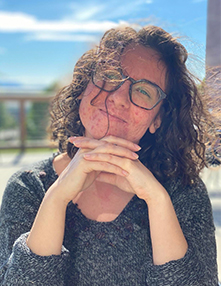Ray Kathryn Morgen Kennedy Center American College Theatre Festival Award

About my Senior Project
I started my concentration, Neuropsychology in Theatrical Sound Design & Performance, in Fall 2019 with the idea that my senior project would be a culminating production of a story album that I wrote and recorded, then designed and performed for a live audience. Clearly, one of the realities that emerged as the pandemic took hold was that my senior project would have to change.
In early September, my Sound Design instructor (in the theatre department) emailed me with an opportunity to design the sound for the fall production of No Exit at the university, and I recognized it could qualify as my Fairhaven senior project. I’ve had theatrical sound design projects before, but this would be the first in which I was wholly responsible for the outcome. It would also be my first remote sound design project, as I recently moved to Maryland for personal reasons.
I was particularly enthused because No Exit is an existential analysis of human connections. It was the perfect (plan b) culmination of my studies in psychology, storytelling, and audio tech. I finally had an opportunity to use my education in neurobiology to augment my aural storytelling. In particular, I was excited by questions of the psychoacoustics of the universe the play takes in. By psychoacoustics, I mean the way the sound behaves in relation to how humans experience sound, in this case, specifically the human characters of the play. So: how does sound behave in the world of this play? (Still not entirely sure, it’s a weird one. Lots of opening and closing of portals. In some cases a kind of omnipotent taunting occurs.) In this room? (The room is very closed off.) How does each character experience sound? (It changes throughout the play!) These questions were supplemented and contrasted by the reality of the actual acoustics—how does sound travel through the stage, the set, and psychoacoustics—how is the audience experiencing it, of the space.
The play takes place in a single room in hell. Three characters: Cradeau, Estelle, and Inez, are trapped in the room for eternity. During the show, there are moments where a kind of metaphysical window opens for a given character to view the goings-on of the living on Earth. Time is one of the recurring themes of the show. Earth-time is significantly faster than hell-time. I spent many brainstorming sessions in conversation with the director about the question of orienting in time. Do we orient the audience to Earth-time or Hell-time? (Hell-time.) When we hear about the state of the living, are we experiencing a shift in perspective to their time? (No.) Or are we, the audience, experiencing the distortion of Earth-time through the lens of Hell-time? (Yes.) These questions provided the basis for the technical skills and tools I used to tell the story through sound.
I could not be more pleased with how my senior project turned out. As I envision what’s ahead, I recognize that the experience has changed my ideas of what the future looks like for me. My pending applications to graduate schools now include MFA Sound Design programs.
Statement from the WWU Theatre Dept:
Congratulations to the No Exit cast, crew, and creative team for their hard work and wonderful production. Our respondent from the Kennedy Center American College Theatre Festival made the following awards from our production:
- Meritorious Achievement in Ensemble Acting to Madeline Cooper, Jesse Gervais, Sepanta Yaghmaee, and Shona Carter
- Meritorious Achievement in Assistant Directing to Elijah Rakha-Sheketoff
- Meritorious Achievement in Sound Design to Ray Morgen
- Meritorious Achievement in Costume Design to Camryn Gipe
- Meritorious Achievement in Stage Management to Nina Stanyo
Congratulations to all on these well-deserved awards and to your incredible work on the production!
About the KCACTF (from the website: https://www.kcactf7.org/about-kcactf7/)
Started in 1969 by Roger L. Stevens, the Kennedy Center’s founding chairman, the Kennedy Center American College Theater (KCACTF) is a national theater program involving 18,000 students from colleges and universities nationwide which has served as a catalyst in improving the quality of college theater in the United States. The KCACTF has grown into a network of more than 600 academic institutions throughout the country, where theater departments and student artists showcase their work and receive outside assessment by KCACTF respondents.
KCACTF is a year-round program in eight geographic regions in the United States. Region7 contains states of the Northwest: Alaska, Washington, Oregon, Idaho, Colorado, and Wyoming, along with Hawaii and northern sections of Nevada and California